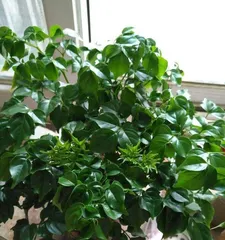The happiness tree (Radermachera sinica) is widely cultivated for its advantages such as longevity, cold tolerance, and air purification. However, improper care can lead to yellowing leaves, affecting its appearance and health. This article will introduce how to solve the problem of yellowing leaves from multiple perspectives.

I. Understand the Growing Environment of the Happiness Tree
Before cultivating a happiness tree at home, it is necessary to understand its growing environment, including suitable conditions such as temperature, humidity, and light. Only by creating a suitable growing environment can the happiness tree grow healthily.
II. Water Correctly
The happiness tree has a high demand for water, but overwatering can lead to root hypoxia, which in turn causes yellowing leaves. Watering should be done on a regular schedule, ensuring the topsoil remains moist but not waterlogged.

III. Fertilize Appropriately
The happiness tree has low nutritional requirements; excessive fertilization can damage the root system, leading to poor growth. Appropriate fertilizer should be chosen, and fertilization should be carried out according to the fertilizer's instructions.
IV. Pay Attention to Drainage
The happiness tree requires adequate drainage during its growth process. Poor drainage can easily cause root hypoxia, leading to yellowing leaves. The holes at the bottom of the pot should be cleared, and a layer of gravel or porous material should be placed at the bottom of the pot to promote drainage.
V. Prune Appropriately
Excessive dense growth of branches and leaves affects photosynthesis and can easily lead to nutritional imbalance. Branches and leaves should be pruned appropriately to increase ventilation and light penetration, ensuring the leaves' surface area is exposed to light.

VI. Prevent Drought
During its growth, the happiness tree can experience yellowing leaves due to drought. To prevent drought, the plant can be kept indoors, watered regularly by spraying, and the air humidity maintained.
VII. Avoid Excessive Light
Direct sunlight on the happiness tree can easily cause leaf scorch, leading to yellowing leaves. When planting a happiness tree, it should be placed in a location away from direct sunlight.
VIII. Pay Attention to Pest and Disease Control
During its growth, the happiness tree is susceptible to pests and diseases, which affect its health and can cause yellowing leaves. Pests and diseases should be regularly controlled to maintain the healthy growth of the happiness tree.
IX. Use Nutrient Solution
To maintain the healthy growth of the happiness tree, a nutrient solution can be used regularly to provide essential nutrients and increase its resistance to pests and diseases.
X. Repotting and Soil Change
During its growth, the happiness tree needs to have its pot and soil changed appropriately to ensure the root system's aeration and water permeability. When repotting, a new pot of suitable size should be chosen, and the soil should be replaced with soil rich in organic matter.
XI. Create a Suitable Environment
To create a suitable growing environment, some green plants can be placed around the happiness tree to increase air humidity and negative ion concentration, improving the tree's health.
XII. Control Indoor Temperature
During the happiness tree's growth, the indoor temperature should be controlled to suit its growing environment. In the summer, the indoor temperature can be kept below 22°C through appropriate cooling methods.
XIII. Enhance Ventilation
During the happiness tree's growth, ventilation and light penetration should be enhanced to ensure that the leaves receive sufficient sunlight and air, promoting healthy growth.
XIV. Keep it Clean
The leaves and the surface of the pot can easily accumulate dust and debris, affecting their ability to absorb light and nutrients. The surface of the pot and the leaves should be cleaned frequently to keep them clean and hygienic.
XV.
Through the measures mentioned above, we can effectively solve the problem of yellowing leaves on the happiness tree. As long as a suitable growing environment is created, watering and fertilizing are done regularly, and pruning is done appropriately, the happiness tree can grow healthily and bring us more beauty.